
- •About the Author
- •About the Technical Editor
- •Credits
- •Is This Book for You?
- •Software Versions
- •Conventions This Book Uses
- •What the Icons Mean
- •How This Book Is Organized
- •How to Use This Book
- •What’s on the Companion CD
- •What Is Excel Good For?
- •What’s New in Excel 2010?
- •Moving around a Worksheet
- •Introducing the Ribbon
- •Using Shortcut Menus
- •Customizing Your Quick Access Toolbar
- •Working with Dialog Boxes
- •Using the Task Pane
- •Creating Your First Excel Worksheet
- •Entering Text and Values into Your Worksheets
- •Entering Dates and Times into Your Worksheets
- •Modifying Cell Contents
- •Applying Number Formatting
- •Controlling the Worksheet View
- •Working with Rows and Columns
- •Understanding Cells and Ranges
- •Copying or Moving Ranges
- •Using Names to Work with Ranges
- •Adding Comments to Cells
- •What Is a Table?
- •Creating a Table
- •Changing the Look of a Table
- •Working with Tables
- •Getting to Know the Formatting Tools
- •Changing Text Alignment
- •Using Colors and Shading
- •Adding Borders and Lines
- •Adding a Background Image to a Worksheet
- •Using Named Styles for Easier Formatting
- •Understanding Document Themes
- •Creating a New Workbook
- •Opening an Existing Workbook
- •Saving a Workbook
- •Using AutoRecover
- •Specifying a Password
- •Organizing Your Files
- •Other Workbook Info Options
- •Closing Workbooks
- •Safeguarding Your Work
- •Excel File Compatibility
- •Exploring Excel Templates
- •Understanding Custom Excel Templates
- •Printing with One Click
- •Changing Your Page View
- •Adjusting Common Page Setup Settings
- •Adding a Header or Footer to Your Reports
- •Copying Page Setup Settings across Sheets
- •Preventing Certain Cells from Being Printed
- •Preventing Objects from Being Printed
- •Creating Custom Views of Your Worksheet
- •Understanding Formula Basics
- •Entering Formulas into Your Worksheets
- •Editing Formulas
- •Using Cell References in Formulas
- •Using Formulas in Tables
- •Correcting Common Formula Errors
- •Using Advanced Naming Techniques
- •Tips for Working with Formulas
- •A Few Words about Text
- •Text Functions
- •Advanced Text Formulas
- •Date-Related Worksheet Functions
- •Time-Related Functions
- •Basic Counting Formulas
- •Advanced Counting Formulas
- •Summing Formulas
- •Conditional Sums Using a Single Criterion
- •Conditional Sums Using Multiple Criteria
- •Introducing Lookup Formulas
- •Functions Relevant to Lookups
- •Basic Lookup Formulas
- •Specialized Lookup Formulas
- •The Time Value of Money
- •Loan Calculations
- •Investment Calculations
- •Depreciation Calculations
- •Understanding Array Formulas
- •Understanding the Dimensions of an Array
- •Naming Array Constants
- •Working with Array Formulas
- •Using Multicell Array Formulas
- •Using Single-Cell Array Formulas
- •Working with Multicell Array Formulas
- •What Is a Chart?
- •Understanding How Excel Handles Charts
- •Creating a Chart
- •Working with Charts
- •Understanding Chart Types
- •Learning More
- •Selecting Chart Elements
- •User Interface Choices for Modifying Chart Elements
- •Modifying the Chart Area
- •Modifying the Plot Area
- •Working with Chart Titles
- •Working with a Legend
- •Working with Gridlines
- •Modifying the Axes
- •Working with Data Series
- •Creating Chart Templates
- •Learning Some Chart-Making Tricks
- •About Conditional Formatting
- •Specifying Conditional Formatting
- •Conditional Formats That Use Graphics
- •Creating Formula-Based Rules
- •Working with Conditional Formats
- •Sparkline Types
- •Creating Sparklines
- •Customizing Sparklines
- •Specifying a Date Axis
- •Auto-Updating Sparklines
- •Displaying a Sparkline for a Dynamic Range
- •Using Shapes
- •Using SmartArt
- •Using WordArt
- •Working with Other Graphic Types
- •Using the Equation Editor
- •Customizing the Ribbon
- •About Number Formatting
- •Creating a Custom Number Format
- •Custom Number Format Examples
- •About Data Validation
- •Specifying Validation Criteria
- •Types of Validation Criteria You Can Apply
- •Creating a Drop-Down List
- •Using Formulas for Data Validation Rules
- •Understanding Cell References
- •Data Validation Formula Examples
- •Introducing Worksheet Outlines
- •Creating an Outline
- •Working with Outlines
- •Linking Workbooks
- •Creating External Reference Formulas
- •Working with External Reference Formulas
- •Consolidating Worksheets
- •Understanding the Different Web Formats
- •Opening an HTML File
- •Working with Hyperlinks
- •Using Web Queries
- •Other Internet-Related Features
- •Copying and Pasting
- •Copying from Excel to Word
- •Embedding Objects in a Worksheet
- •Using Excel on a Network
- •Understanding File Reservations
- •Sharing Workbooks
- •Tracking Workbook Changes
- •Types of Protection
- •Protecting a Worksheet
- •Protecting a Workbook
- •VB Project Protection
- •Related Topics
- •Using Excel Auditing Tools
- •Searching and Replacing
- •Spell Checking Your Worksheets
- •Using AutoCorrect
- •Understanding External Database Files
- •Importing Access Tables
- •Retrieving Data with Query: An Example
- •Working with Data Returned by Query
- •Using Query without the Wizard
- •Learning More about Query
- •About Pivot Tables
- •Creating a Pivot Table
- •More Pivot Table Examples
- •Learning More
- •Working with Non-Numeric Data
- •Grouping Pivot Table Items
- •Creating a Frequency Distribution
- •Filtering Pivot Tables with Slicers
- •Referencing Cells within a Pivot Table
- •Creating Pivot Charts
- •Another Pivot Table Example
- •Producing a Report with a Pivot Table
- •A What-If Example
- •Types of What-If Analyses
- •Manual What-If Analysis
- •Creating Data Tables
- •Using Scenario Manager
- •What-If Analysis, in Reverse
- •Single-Cell Goal Seeking
- •Introducing Solver
- •Solver Examples
- •Installing the Analysis ToolPak Add-in
- •Using the Analysis Tools
- •Introducing the Analysis ToolPak Tools
- •Introducing VBA Macros
- •Displaying the Developer Tab
- •About Macro Security
- •Saving Workbooks That Contain Macros
- •Two Types of VBA Macros
- •Creating VBA Macros
- •Learning More
- •Overview of VBA Functions
- •An Introductory Example
- •About Function Procedures
- •Executing Function Procedures
- •Function Procedure Arguments
- •Debugging Custom Functions
- •Inserting Custom Functions
- •Learning More
- •Why Create UserForms?
- •UserForm Alternatives
- •Creating UserForms: An Overview
- •A UserForm Example
- •Another UserForm Example
- •More on Creating UserForms
- •Learning More
- •Why Use Controls on a Worksheet?
- •Using Controls
- •Reviewing the Available ActiveX Controls
- •Understanding Events
- •Entering Event-Handler VBA Code
- •Using Workbook-Level Events
- •Working with Worksheet Events
- •Using Non-Object Events
- •Working with Ranges
- •Working with Workbooks
- •Working with Charts
- •VBA Speed Tips
- •What Is an Add-In?
- •Working with Add-Ins
- •Why Create Add-Ins?
- •Creating Add-Ins
- •An Add-In Example
- •System Requirements
- •Using the CD
- •What’s on the CD
- •Troubleshooting
- •The Excel Help System
- •Microsoft Technical Support
- •Internet Newsgroups
- •Internet Web sites
- •End-User License Agreement

Part II: Working with Formulas and Functions
continued
If you need to distinguish zeros from blank cells, you must modify the lookup formula by adding an IF function to check whether the length of the returned value is 0. When the looked up value is blank, the length of the return value is 0. In all other cases, the length of the returned value is non-zero. The following formula displays an empty string (a blank) whenever the length of the looked-up value is zero and the actual value whenever the length is anything but zero:
=IF(LEN(VLOOKUP(B1,D2:E8,2))=0,””,(VLOOKUP(B1,D2:E8,2)))
Alternatively, you can specifically check for an empty string, as in the following formula:
=IF(VLOOKUP(B1,D2:E8,2)=””,””,(VLOOKUP(B1,D2:E8,2)))
Specialized Lookup Formulas
You can use additional types of lookup formulas to perform more specialized lookups. For example, you can look up an exact value, search in another column besides the first in a lookup table, perform a case-sensitive lookup, return a value from among multiple lookup tables, and perform other specialized and complex lookups.
On the CD
The examples in this section are available on the companion CD-ROM. The file is named specialized lookup examples.xlsx.
Looking up an exact value
As demonstrated in the previous examples, VLOOKUP and HLOOKUP don’t necessarily require an exact match between the value to be looked up and the values in the lookup table. An example is looking up a tax rate in a tax table. In some cases, you may require a perfect match. For example, when looking up an employee number, you would require a perfect match for the number.
To look up an exact value only, use the VLOOKUP (or HLOOKUP) function with the optional fourth argument set to FALSE.
Figure 14.6 shows a worksheet with a lookup table that contains employee numbers (column C) and employee names (column D). The lookup table is named EmpList. The formula in cell B2, which follows, looks up the employee number entered in cell B1 and returns the corresponding employee name:
=VLOOKUP(B1,EmpList,2,FALSE)
Because the last argument for the VLOOKUP function is FALSE, the function returns a value only if an exact match is found. If the value is not found, the formula returns #N/A. This result, of course,
318
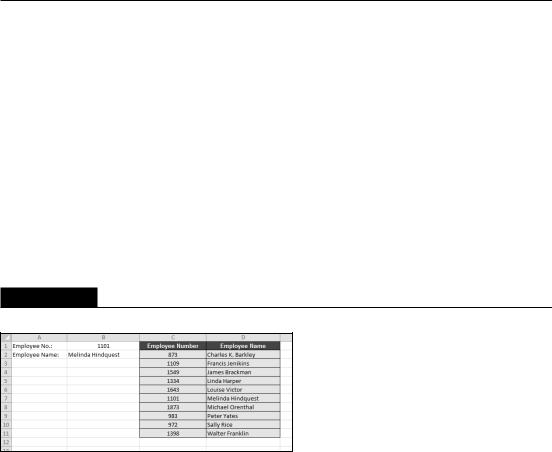
Chapter 14: Creating Formulas That Look Up Values
is exactly what you want to happen because returning an approximate match for an employee number makes no sense. Also, notice that the employee numbers in column C are not in ascending order. If the last argument for VLOOKUP is FALSE, the values need not be in ascending order.
Tip
If you prefer to see something other than #N/A when the employee number is not found, you can use the IFERROR function to test for the error result and substitute a different string. The following formula displays the text Not Found rather than #N/A:
=IFERROR(VLOOKUP(B1,EmpList,2,FALSE),”Not Found”)
IFERROR works only with Excel 2007 and Excel 2010. For compatibility with previous versions, use the following formula:
=IF(ISNA(VLOOKUP(B1,EmpList,2,FALSE)),”Not Found”,
VLOOKUP(B1,EmpList,2,FALSE))
FIGURE 14.6
This lookup table requires an exact match.
Looking up a value to the left
The VLOOKUP function always looks up a value in the first column of the lookup range. But what if you want to look up a value in a column other than the first column? It would be helpful if you could supply a negative value for the third argument for VLOOKUP — but Excel doesn’t allow it.
Figure 14.7 illustrates the problem. Suppose that you want to look up the batting average (column B, in a range named Averages) of a player in column C (in a range named Players). The player you want data for appears in a cell named LookupValue. The VLOOKUP function won’t work because the data isn’t arranged correctly. One option is to rearrange your data, but sometimes that’s not possible.
One solution is to use the LOOKUP function, which requires two range arguments. The following formula (in cell F3) returns the batting average from column B of the player name contained in the cell named LookupValue:
=LOOKUP(LookupValue,Players,Averages)
319
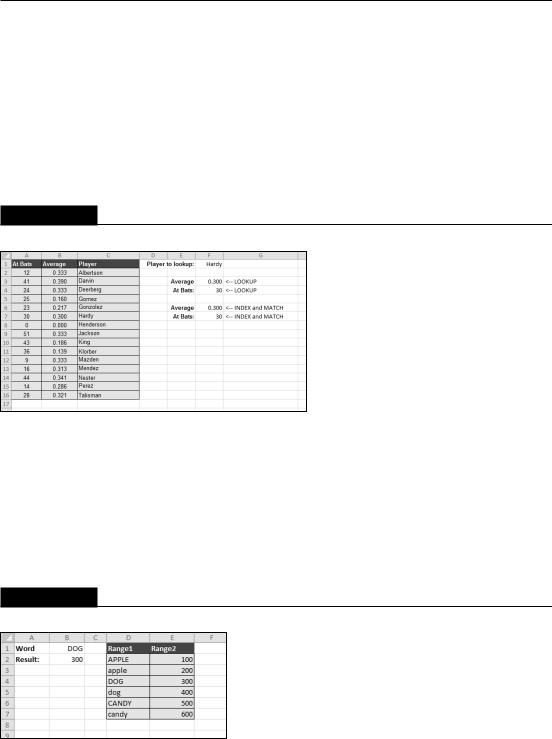
Part II: Working with Formulas and Functions
Using the LOOKUP function requires that the lookup range (in this case, the Players range) is in ascending order. In addition to this limitation, the formula suffers from a slight problem: If you enter a nonexistent player (in other words, the LookupValue cell contains a value not found in the Players range), the formula returns an erroneous result.
A better solution uses the INDEX and MATCH functions. The formula that follows works just like the previous one except that it returns #N/A if the player is not found. Another advantage is that the player names need not be sorted.
=INDEX(Averages,MATCH(LookupValue,Players,0))
FIGURE 14.7
The VLOOKUP function can’t look up a value in column B, based on a value in column C.
Performing a case-sensitive lookup
The Excel lookup functions (LOOKUP, VLOOKUP, and HLOOKUP) are not case sensitive. For example, if you write a lookup formula to look up the text budget, the formula considers any of the following a match: BUDGET, Budget, or BuDgEt.
Figure 14.8 shows a simple example. Range D2:D7 is named Range1, and range E2:E7 is named Range2. The word to be looked up appears in cell B1 (named Value).
FIGURE 14.8
Using an array formula to perform a case-sensitive lookup.
320
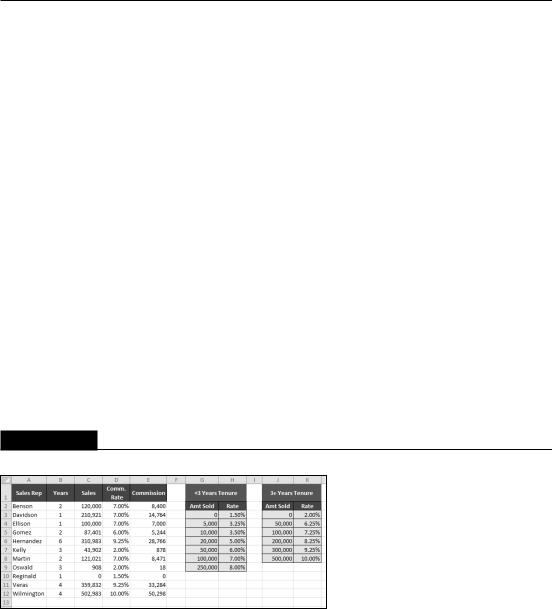
Chapter 14: Creating Formulas That Look Up Values
The array formula that follows is in cell B2. This formula does a case-sensitive lookup in Range1 and returns the corresponding value in Range2.
{=INDEX(Range2,MATCH(TRUE,EXACT(Value,Range1),0))}
The formula looks up the word DOG (uppercase) and returns 300. The following standard LOOKUP formula (which is not case sensitive) returns 400:
=LOOKUP(Value,Range1,Range2)
Note
When entering an array formula, remember to use Ctrl+Shift+Enter. n
Looking up a value from multiple lookup tables
You can, of course, have any number of lookup tables in a worksheet. In some situations, your formula may need to decide which lookup table to use. Figure 14.9 shows an example.
This workbook calculates sales commission and contains two lookup tables: G3:H9 (named CommTable1) and J3:K8 (named CommTable2). The commission rate for a particular sales representative depends on two factors: the sales rep’s years of service (column B) and the amount sold (column C). Column D contains formulas that look up the commission rate from the appropriate table. For example, the formula in cell D2 is
=VLOOKUP(C2,IF(B2<3,CommTable1,CommTable2),2)
FIGURE 14.9
This worksheet demonstrates the use of multiple lookup tables.
The second argument for the VLOOKUP function consists of an IF formula that uses the value in column B to determine which lookup table to use.
The formula in column E simply multiplies the sales amount in column C by the commission rate in column D. The formula in cell E2, for example, is
=C2*D2
321

Part II: Working with Formulas and Functions
Determining letter grades for test scores
A common use of a lookup table is to assign letter grades for test scores. Figure 14.10 shows a worksheet with student test scores. The range E2:F6 (named GradeList) displays a lookup table used to assign a letter grade to a test score.
Column C contains formulas that use the VLOOKUP function and the lookup table to assign a grade based on the score in column B. The formula in cell C2, for example, is
=VLOOKUP(B2,GradeList,2)
When the lookup table is small (as in the example shown earlier in Figure 14.10), you can use a literal array in place of the lookup table. The formula that follows, for example, returns a letter grade without using a lookup table. Rather, the information in the lookup table is hard-coded into an array. See Chapter 17 for more information about arrays.
=VLOOKUP(B2,{0,”F”;40,”D”;70,”C”;80,”B”;90,”A”},2)
Another approach, which uses a more legible formula, is to use the LOOKUP function with two array arguments:
=LOOKUP(B2,{0,40,70,80,90},{“F”,”D”,”C”,”B”,”A”})
FIGURE 14.10
Looking up letter grades for test scores.
Calculating a grade-point average
A student’s grade-point average (GPA) is a numerical measure of the average grade received for classes taken. This discussion assumes a letter grade system, in which each letter grade is assigned a numeric value (A=4, B=3, C=2, D=1, and F=0). The GPA comprises an average of the numeric
322
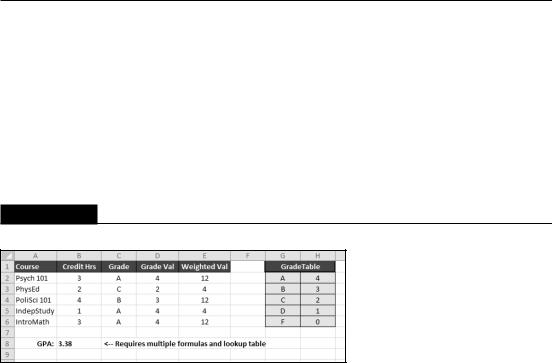
Chapter 14: Creating Formulas That Look Up Values
grade values weighted by the credit hours of the course. A one-hour course, for example, receives less weight than a three-hour course. The GPA ranges from 0 (all Fs) to 4.00 (all As).
Figure 14.11 shows a worksheet with information for a student. This student took five courses, for a total of 13 credit hours. Range B2:B6 is named CreditHours. The grades for each course appear in column C. (Range C2:C6 is named Grades.) Column D uses a lookup formula to calculate the grade value for each course. The lookup formula in cell D2, for example, follows. This formula uses the lookup table in G2:H6 (named GradeTable).
=VLOOKUP(C2,GradeTable,2,FALSE)
FIGURE 14.11
Using multiple formulas to calculate a GPA.
Formulas in column E calculate the weighted values. The formula in cell E2 is
=D2*B2
Cell B8 computes the GPA by using the following formula:
=SUM(E2:E6)/SUM(B2:B6)
The preceding formulas work fine, but you can streamline the GPA calculation quite a bit. In fact, you can use a single array formula to make this calculation and avoid using the lookup table and the formulas in columns D and E. This array formula does the job:
{=SUM((MATCH(Grades,{“F”,”D”,”C”,”B”,”A”},0)-1)*CreditHours) /SUM(CreditHours)}
Performing a two-way lookup
Figure 14.12 shows a worksheet with a table that displays product sales by month. To retrieve sales for a particular month and product, the user enters a month in cell B1 and a product name in cell B2.
323
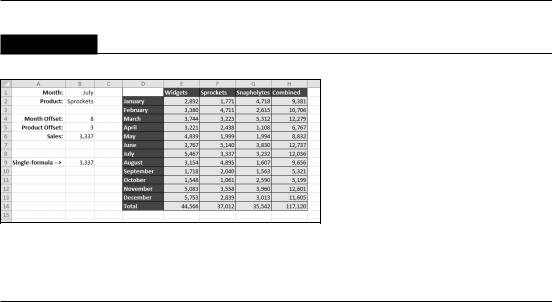
Part II: Working with Formulas and Functions
FIGURE 14.12
This table demonstrates a two-way lookup.
To simplify things, the worksheet uses the following named ranges:
Month |
B1 |
Product |
B2 |
|
|
Table |
D1:H14 |
|
|
MonthList |
D1:D14 |
|
|
ProductList |
D1:H1 |
|
|
The following formula (in cell B4) uses the MATCH function to return the position of the Month within the MonthList range. For example, if the month is January, the formula returns 2 because January is the second item in the MonthList range (the first item is a blank cell, D1).
=MATCH(Month,MonthList,0)
The formula in cell B5 works similarly but uses the ProductList range.
=MATCH(Product,ProductList,0)
The final formula, in cell B6, returns the corresponding sales amount. It uses the INDEX function with the results from cells B4 and B5.
=INDEX(Table,B4,B5)
You can, of course, combine these formulas into a single formula, as shown here:
=INDEX(Table,MATCH(Month,MonthList,0),MATCH(Product,ProductList,0))
324
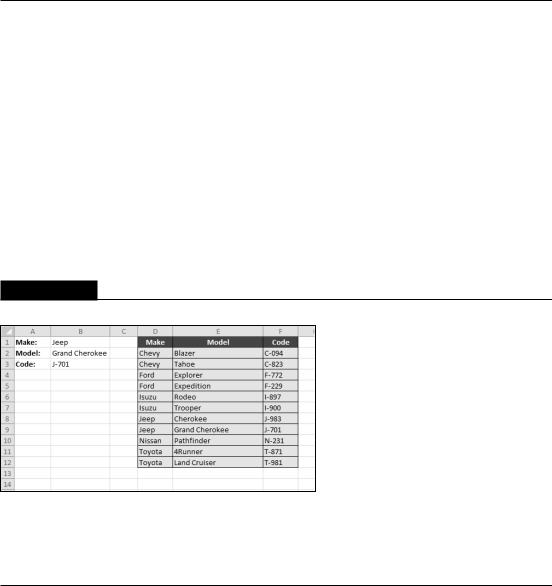
Chapter 14: Creating Formulas That Look Up Values
Tip
Another way to accomplish a two-way lookup is to provide a name for each row and column of the table. A quick way to do so is to select the table and choose Formulas Defined Names Create from Selection. In the Create Names from Selection dialog box, select the Top Row and Left Column check boxes. After creating the names, you can use a simple formula, such as:
= Sprockets July
This formula, which uses the range intersection operator (a space), returns July sales for Sprockets. See Chapter 10 for details about the range intersection operator. n
Performing a two-column lookup
Some situations may require a lookup based on the values in two columns. Figure 14.13 shows an example.
FIGURE 14.13
This workbook performs a lookup by using information in two columns (D and E).
The lookup table contains automobile makes and models and a corresponding code for each. The worksheet uses named ranges, as shown here:
F2:F12 |
Code |
B1 |
Make |
|
|
B2 |
Model |
|
|
D2:D12 |
Makes |
|
|
E2:E12 |
Models |
325
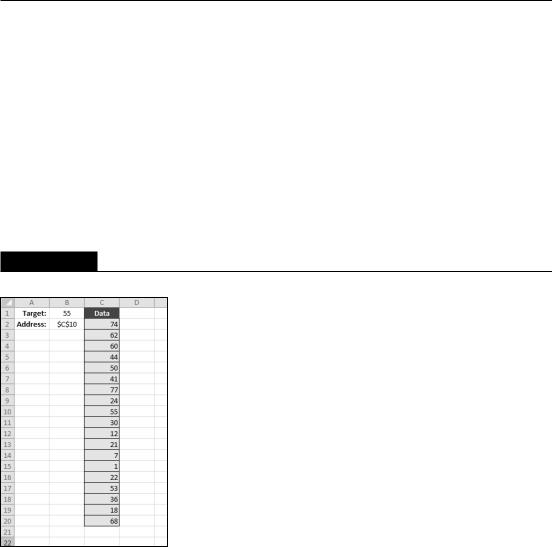
Part II: Working with Formulas and Functions
The following array formula displays the corresponding code for an automobile make and model:
{=INDEX(Code,MATCH(Make&Model,Makes&Models,0))}
This formula works by concatenating the contents of Make and Model and then searching for this text in an array consisting of the concatenated corresponding text in Makes and Models.
Determining the cell address of a value within a range
Most of the time, you want your lookup formula to return a value. You may, however, need to determine the cell address of a particular value within a range. For example, Figure 14.14 shows a worksheet with a range of numbers that occupies a single column (named Data). Cell B1, which contains the value to look up, is named Target.
FIGURE 14.14
The formula in cell B2 returns the address in the Data range for the value in cell B1.
The formula in cell B2, which follows, returns the address of the cell in the Data range that contains the Target value:
=ADDRESS(ROW(Data)+MATCH(Target,Data,0)-1,COLUMN(Data))
If the Data range occupies a single row, use this formula to return the address of the Target value:
=ADDRESS(ROW(Data),COLUMN(Data)+MATCH(Target,Data,0)-1)
If the Data range contains more than one instance of the Target value, the address of the first occurrence is returned. If the Target value isn’t found in the Data range, the formula returns #N/A.
326
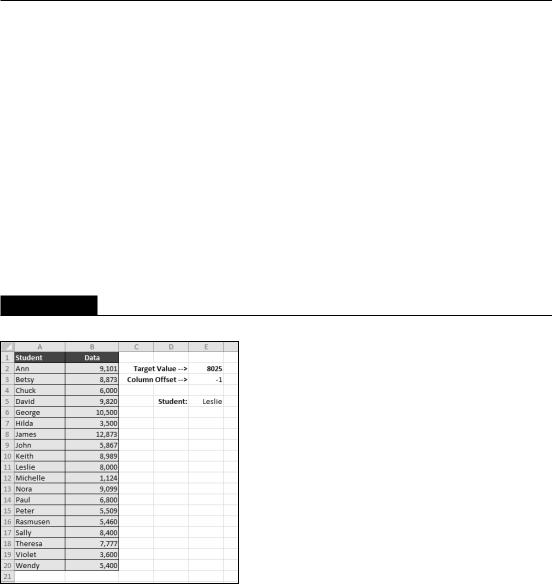
Chapter 14: Creating Formulas That Look Up Values
Looking up a value by using the closest match
The VLOOKUP and HLOOKUP functions are useful in the following situations:
•You need to identify an exact match for a target value. Use FALSE as the function’s fourth argument.
•You need to locate an approximate match. If the function’s fourth argument is TRUE or omitted and an exact match is not found, the next largest value less than the lookup value is returned.
But what if you need to look up a value based on the closest match? Neither VLOOKUP nor HLOOKUP can do the job.
Figure 14.15 shows a worksheet with student names in column A and values in column B. Range B2:B20 is named Data. Cell E2, named Target, contains a value to search for in the Data range. Cell E3, named ColOffset, contains a value that represents the column offset from the Data range.
FIGURE 14.15
This workbook demonstrates how to perform a lookup by using the closest match.
The array formula that follows identifies the closest match to the Target value in the Data range and returns the names of the corresponding student in column A (that is, the column with an offset of –1). The formula returns Leslie (with a matching value of 8,000, which is the one closest to the Target value of 8,025).
{=INDIRECT(ADDRESS(ROW(Data)+MATCH(MIN(ABS(Target-Data)), ABS(Target-Data),0)-1,COLUMN(Data)+ColOffset))}
327

Part II: Working with Formulas and Functions
If two values in the Data range are equidistant from the Target value, the formula uses the first one in the list.
The value in ColOffset can be negative (for a column to the left of Data), positive (for a column to the right of Data), or 0 (for the actual closest match value in the Data range).
To understand how this formula works, you need to understand the INDIRECT function. This function’s first argument is a text string in the form of a cell reference (or a reference to a cell that contains a text string). In this example, the text string is created by the ADDRESS function, which accepts a row and column reference and returns a cell address.
328
